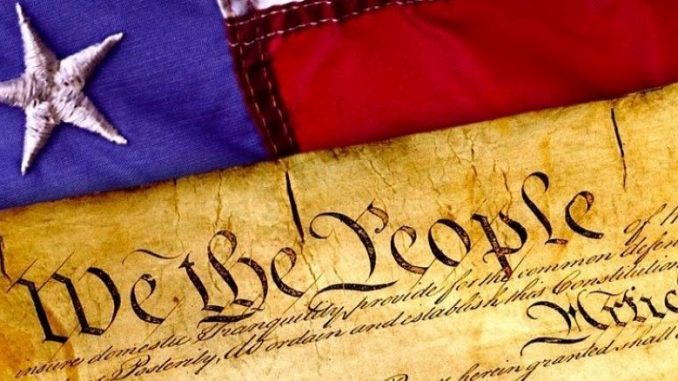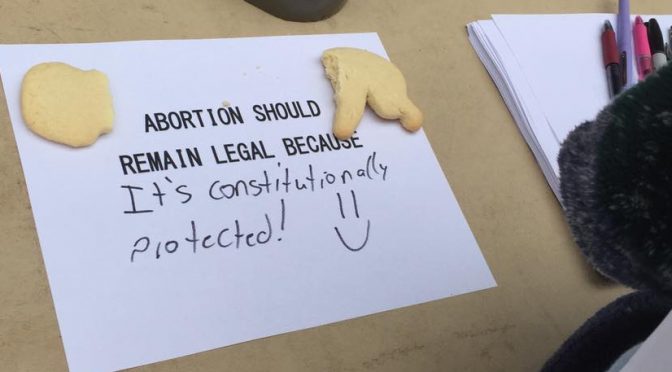
LiveActionNews.org — A few years ago, some students at the University of North Georgia made cookies and put on a celebration. What were they celebrating? Why, abortion, of course.
As UNG Students for Life reported, members of the Skeptics Society encouraged visitors to take fetus shaped cookies and give reasons why abortion should stay legal. Examples ranged from, “A woman controls her own body,” to, “My vagina is too pretty to let a fetus crawl out.” And then there was this:

It’s common to hear how “abortion rights” are protected in the Constitution. When confronted with that argument, it’s best to respond with a single question.
Where?
You’ll typically get a puzzled look, which shouldn’t be surprising. After all, even the Supreme Court struggled to find an answer.
In Roe v. Wade, the Supreme Court discovered a constitutional right to abortion. That’s interesting, because nowhere in the Constitution does the word “abortion” even appear. They got around this by claiming abortion falls under the “right of privacy.” Where’s that right spelled out? It isn’t. Justice Harry Blackmun wrote the majority opinion in Roe, and even he admitted “the Constitution does not explicitly mention any right of privacy.” How do you go about finding rights that the Constitution makes no mention of? I’m gonna let Justice Blackmun explain that himself:
In a line of decisions, however, going back perhaps as far as Union Pacific R. Co. v. Botsford, 141 U.S. 250, 251 (1891), the Court has recognized that a right of personal privacy, or a guarantee of certain areas or zones of privacy, does exist under the Constitution.
In varying contexts, the Court or individual Justices have, indeed, found at least the roots of that right in the First Amendment, Stanley v. Georgia, 394 U.S. 557, 564 (1969); in the Fourth and Fifth Amendments, Terry v. Ohio, 392 U.S. 1, 8 -9 (1968), Katz v. United States, 389 U.S. 347, 350 (1967), Boyd v. United States, 116 U.S. 616 (1886), see Olmstead v. United States, 277 U.S. 438, 478 (1928) (Brandeis, J., dissenting); in the penumbras of the Bill of Rights, Griswold v. Connecticut, 381 U.S., at 484 -485; in the Ninth Amendment, id., at 486 (Goldberg, J., concurring); or in the concept of liberty guaranteed by the first section of the Fourteenth Amendment, see Meyer v. Nebraska,262 U.S. 390, 399 (1923). These decisions make it clear that only personal rights that can be deemed “fundamental” or “implicit in the concept of ordered liberty,” Palko v. Connecticut, 302 U.S. 319, 325 (1937), are included in this guarantee of personal privacy.
They also make it clear that the right has some extension to activities relating to marriage, Loving v. Virginia, 388 U.S. 1, 12 (1967); procreation, Skinner v. Oklahoma,316 U.S. 535, 541 -542 (1942); contraception, Eisenstadt v. Baird, 405 U.S., at 453 -454; id., at 460, 463-465 [410 U.S. 113, 153] (WHITE, J., concurring in result); family relationships, Prince v. Massachusetts, 321 U.S. 158, 166 (1944); and child rearing and education, Pierce v. Society of Sisters, 268 U.S. 510, 535 (1925), Meyer v. Nebraska, supra.
So, cases about pornography, police search procedure, telephone wiretap use, foreign language instruction, private education, interracial marriage, birth control, and the distribution of religious materials all add up to a “right of privacy.” Okay…and why is abortion part of it? I don’t know–Blackmun just insisted that it was.
This right of privacy, whether it be founded in the Fourteenth Amendment’s concept of personal liberty and restrictions upon state action, as we feel it is, or, as the District Court determined, in the Ninth Amendment’s reservation of rights to the people, is broad enough to encompass a woman’s decision whether or not to terminate her pregnancy.
Also mentioned was “the detriment” of being denied the chance to abort. Dr. Anthony Levatino has performed over twelve hundred abortions, and in the video below, he describes what’s done to fetuses in the second trimester. Watch it and decide how much detriment they experience.
RELATED NEWS: If Late-Term Abortion Isn’t Torture, What Is?
After the amniotic fluid is removed, the abortionist uses a sopher clamp — a grasping instrument with rows of sharp “teeth” — to grasp and pull the baby’s arms and legs, tearing the limbs from the child’s body. The abortionist continues to grasp intestines, spine, heart, lungs, and any other limbs or body parts. The most difficult part of the procedure is usually finding, grasping and crushing the baby’s head. After removing pieces of the child’s skull, the abortionist uses a curette to scrape the uterus and remove the placenta and any remaining parts of the baby.
Not that children in the womb are the only ones for whom abortion has been detrimental: in case after case, child sex predators have used abortion to cover up their crimes and keep abusing their victims. Apparently Blackmun didn’t anticipate that.
RELATED NEWS: Here Are 10 Child Rapists Planned Parenthood Helped
This all helps to illustrate how important judicial appointments are, which is why it’s something pro-lifers won’t compromise on. And while a right to abortion might be popular at the cookie table, you won’t find it in the Constitution. We need judges who are able to see that.
The original version of this article was published on August 25, 2016 at Live Action News. This reprint has been updated, with permission.
Be the first to comment